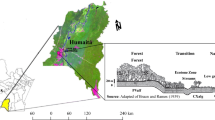Abstract
All living trees (≥30 cm gbh) were enumerated in 104 80×80 m plots arranged along four transects in the Douala-Edea Forest Reserve Cameroun, a system of low-lying ancient coastal sand dunes interspersed by numerous streams and swamps. The extent of permanent and seasonal swamps was recorded for each plot. Two hundred thirty taxa were recognized of which 63% were identified to species. Mean tree density was 376 ha−1, basal area 31.0 m2 ha−1 and number of species per plot 39. The Olacaceae were the most abundant family in terms of basal area, but the Euphorbiaceae the most frequently represented. The most abundant species wasCoula edulis (Olacaceae). Twenty-two plots had most of their area permanently or seasonally swamped. Percentage sand, silt and clay ranged between 32–100, 0–64, 0–21% respectively. The ranges for other variables recorded were: pH (2.7–5.4), organic carbon (1.5–12.4%), available phosphorus (7–90 ppm) and potassium (28–188 ppm), and nitrogen (ammonium 4–40 ppm, nitrate 1–12 ppm).
Classification of the plots on the basis of six soil variables provided three large distinct groups: swamp plots and non-swamp plots, the latter divided into plots of low and high available soil phosphorus. Swamp plots were distinguished by high abundances ofProtomegabaria stapfiana andLibrevillea klainei, though correspondence ordination of plots in these groups showedP. stapfiana associated with more clayey soils andLibrevillea klainei (andGluema ivorensis) on the very sandy soils. Direct gradient analysis highlighted several species associated with these lower phosphorus soils. Available soil phosphorus is not as low at Douala-Edea as in parts of Korup, and the association of these Douala-Edea soils with the Caesalpinioideae is correspondingly weaker.
Similar content being viewed by others
References
Aubréville, A. (ed.), 1963–1983. Flore du Cameroun. 24 vols. Government of the United Republic of the Cameroun.
Austin, M. P., Ashton, P. S. & Greig-Smith, P., 1972. The application of quantitative methods to vegetation survey. III A re-examination of rain forest data from Brunei. J. Ecol. 60: 305–324.
Gartlan, J. S., 1974. The African forests and problems in conservation. Symp. 5th Cong. Int. Primat. Soc. p. 509–524.
Gartlan, J. S., McKey, D. B., Waterman, P. G., Mbi, C. N. & Strusaker, T. T., 1980. A comparative study of the phytochemistry of two African rain forests. Biochem. System. & Ecol. 8: 401–422.
Gartlan, J. S., Newbery, D. McC., Thomas, D. W. & Waterman, P. G., 1985. The influence of topography and soil phosphorus on the vegetation of Korup Forest Reserve, Cameroun. Vegetatio 65: 131–148.
Gazel, J., Hourcq, V. & Nickels, M., 1956. Carte Géologique du Cameroun. Bull. No. 2, Direction des Mines et de la Géologie du Cameroun, Yaoundé.
Hall, J. B. & Swaine, M. D., 1981. Distribution and Ecology of Vascular Plants in a Tropical Forest: Forest Vegetation in Ghana. Junk, The Hague.
Hill, M. O. & Gauch, H. G., 1980. Detrended correspondence analysis: an improved ordination technique. Vegetatio 42: 47–58.
Hori, N., 1977. Landforms and superficial deposits in the coastal region of the Cameroon. In: H.Kadomura (ed.), Geomorphological studies in the forest and savanna areas of the Cameroun, pp. 37–52. Hokkaido Univ. Press, Sapporo, Japan.
Letouzey, R., 1968. Etude Phytogéographique du Cameroun. P. Lechevalier, Paris.
Letouzey, R., 1975. Premières observations concentrant au Cameroun la forêt sur cordons littoraux sablonneux. Adansonia 14: 529–542.
Malloch, D. W., Pirozynski, K. A. & Raven, P. H., 1980. Ecological and evolutionary significance of mycorrhizal symbioses in vascular plants (A review). Proc. Nat. Acad. Sci. U.S.A. 77: 2113–2118.
McKey, D. B., Gartlan, J. S., Waterman, P. G. & Choo, G. M., 1981. Food selection by black colobus monkeys (Colobus satunus) in relation to plant chemistry. Biol. J. Linn. Soc. 16: 115–146.
Newbery, D. McC. & Proctor, J., 1984. Ecological studies in four contrasting lowland rain forests in Gunung Mulu National Park, Sarawak. IV. Associations between tree distribution and soil factors. J. Ecol. 72: 475–493.
Orlóci, L., 1967. An agglomerative method for classification of plant communities. J. Ecol. 55: 197–206.
Polhill, R. M. & Raven, P. H. (ed.), 1980. Advances in legume systematics Part I. Royal Botanic Garden, Kew.
Waterman, P. G., 1983. Distribution of secondary metabolites in rain forest plants: toward an understanding of cause and effect. In: S. L.Sutton, T. C.Whitmore & A. C.Chadwick (eds.), Tropical rain forest: ecology and management, pp. 167–179. Blackwell, Oxford.
Author information
Authors and Affiliations
Additional information
Nomenclature follows Aubréville (1963–1983).
The field work was supported by grant numbers RR00167-14, RR00167-15 and RR0167-16 from the National Institutes of Health for the operation of the Wisconsin Regional Primate Research Center, and N.A.T.O. Scientific Affairs grant number 1748 (to PGW and JSG). It was greatly facilitated by the skill and dedication of Ferdinand Namata. R. M. Polhill and D. W. Thomas assisted considerably in the identification of plant species. Sue Gartlan collected and collated the meteorological data, besides other field support. In the field phase J.S.G., P.G.W. and D.B.McK. were researches attached to the National Office of Scientific and Technical Research (ONAREST), Yaoundé. We thank M. D. Swaine for comments on earlier drafts, R. Letouzey for checking species nomenclature, the Computer Unit at Stirling University for facilities, M. Burnett for the typing at Stirling, and the Department of Soil Science, University of Wisconsin, for undertaking the soil chemical analyses.
Reprint requests to D.McC.N. at Stirling.
Publication No. 23-025 of the Wisconsin Regional Primate Center.
Rights and permissions
About this article
Cite this article
Newbery, D.M., Gartlan, J.S., McKey, D.B. et al. The influence of drainage and soil phosphorus on the vegetation of Douala-Edea Forest Reserve, Cameroun. Vegetatio 65, 149–162 (1986). https://doi.org/10.1007/BF00044815
Accepted:
Issue Date:
DOI: https://doi.org/10.1007/BF00044815




